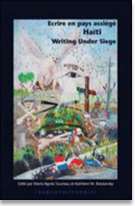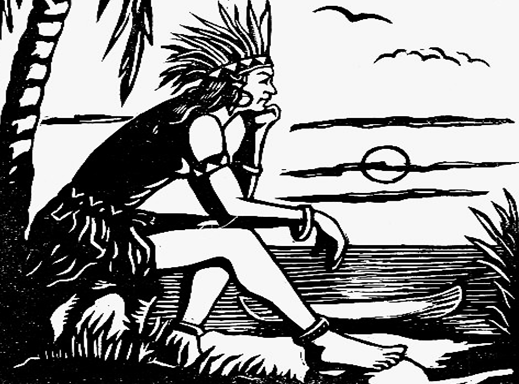 "Anacaona" by Marie-Agnès Sourieau, Ph.D.
"Anacaona" by Marie-Agnès Sourieau, Ph.D.
Sourieau is Professor of Modern Languages and Literature at Fairfield University. She co-edited Ecrire en pays assiege (2004) and Caribbean Creolization: Reflections on the Cultural Dynamics of Language, Literature, and Identity (1998).
According to the Spanish colonial chronicle, the island of Ayti, in 1492, was divided between five kingdoms populated by at least one million Indians. The Cacique Caonabo (Gold chief) reigned over the kingdom of Maguana while his spouse, the radiant and refined Anacaona (Golden flower), a poet and a musician, ruled over Xaragua.
 When in 1500 the administration of Hispaniola was handed over to Nicolás Ovando, Christopher Columbus’ rival, the native population was enslaved to the harshest labors and forced to pay exorbitant tributes. Within ten years, the Indians would be near extinct, except for those living under Anacaona’s sovereignty. Indeed,the kingdom of Xaragua was not fully controlled by the Spaniards although it owed them tributes. Fernández Oviedo, Hispaniola’s first historian, recounts that Queen Anacaona was "courteous, of noble speech and manners, and the Christians’ loyal friend".
When in 1500 the administration of Hispaniola was handed over to Nicolás Ovando, Christopher Columbus’ rival, the native population was enslaved to the harshest labors and forced to pay exorbitant tributes. Within ten years, the Indians would be near extinct, except for those living under Anacaona’s sovereignty. Indeed,the kingdom of Xaragua was not fully controlled by the Spaniards although it owed them tributes. Fernández Oviedo, Hispaniola’s first historian, recounts that Queen Anacaona was "courteous, of noble speech and manners, and the Christians’ loyal friend".
In 1503, wanting peace, and possibly impressed with the Spaniards’ dazzling pomp, Anacaona accepted a treaty of alliance with them. To seal their friendship, she organized festivities for governor Ovando and his entourage during which "areytos" (Tainos ballads and narrative poems) that she composed were performed accompanied by tambourine. In his turn, Ovando invited Anacaona and her people to a large feast set in a field with his army in attendance. Upon an agreed signal –Ovando put his hand on the cross of the Order of Calatrava on his chest–, the meeting house was set on fire and the Spaniards swooped down on the trapped Indians to massacre them. They seized Anacaona and her vassals, hideously tortured them
before executing them. The beautiful Queen of Xaragua was hanged publicly in Santo Domingo a few days later
This genocide would never be forgotten, slowly becoming the metaphor for the island’s tragic destiny, and Anacaona, the mythical figure essential to the Haitian’s collective memory.